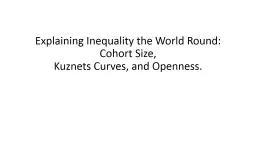PPT-Chapter 14 Inequality: Economic and
Author : genevieve | Published Date : 2023-09-21
Social Perspectives Figure 141 Lorenz Curve for US Household Income 2020 Source US Census Bureau Historical Income Tables Income Inequality Table A2 Figure 142
Presentation Embed Code
Download Presentation
Download Presentation The PPT/PDF document "Chapter 14 Inequality: Economic and" is the property of its rightful owner. Permission is granted to download and print the materials on this website for personal, non-commercial use only, and to display it on your personal computer provided you do not modify the materials and that you retain all copyright notices contained in the materials. By downloading content from our website, you accept the terms of this agreement.
Chapter 14 Inequality: Economic and: Transcript
Download Rules Of Document
"Chapter 14 Inequality: Economic and"The content belongs to its owner. You may download and print it for personal use, without modification, and keep all copyright notices. By downloading, you agree to these terms.
Related Documents














